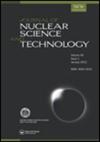Mutual separation of Am and Cm using ADAAM (alkyl DiAmide AMine) and Reduction of Volumes for Liquid Waste generated via batch wise multistage extractions
IF 1.7
4区 工程技术
Q2 NUCLEAR SCIENCE & TECHNOLOGY
引用次数: 0
Abstract
ABSTRACTThe mutual separation of Am and Cm is conducted using an alkyl-diamide amine (ADAAM(EH)) extractant. ADAAM(EH) exhibits extremely high separation factor (SF) with respect to Am and Cm separation (SF = 5.9) in a HNO3-n-dodecane system. The batch-wise multistage extractions are performed using a system containing 0.2 M ADAAM(EH) and 1.5 M HNO3, with their distribution ratios (D) of the system for Am and Cm equal to 2.55 and 0.434, respectively. In this multistage extraction, 3 stages of feed, 9 stages involving scrubbing, and 11 stages involving the use of an organic solvent give 96.5% and 1.06% yields of Am and Cm, respectively. After the mutual separation, the aqueous and the organic phases that includes actinides increases four times in volume compared to the feed solution. Additional extraction steps are to reduce the volume of the solutions including actinides. We use tetraethyl diglycolamide (TEDGA)/water for Am concentration, tetraoctyl diglycolamide/n-dodecane for the intermediate extraction, and TEDGA/water for stripping in the Cm concentration step. Taking the additional steps, Am and Cm can be recovered in just two or three stages in the aqueous phases.KEYWORDS: Solvent extractionAmCmseparationADAAMDisclaimerAs a service to authors and researchers we are providing this version of an accepted manuscript (AM). Copyediting, typesetting, and review of the resulting proofs will be undertaken on this manuscript before final publication of the Version of Record (VoR). During production and pre-press, errors may be discovered which could affect the content, and all legal disclaimers that apply to the journal relate to these versions also. AcknowledgmentsThe authors gratefully acknowledge Dr. Y. Kitatsuji at JAEA for safety management with respect to actinides and Dr. M. Arisaka at JAEA for ICP-measurements.Declaration of Interest StatementNo potential conflict of interest was reported by the authors.Figure 1 Extractant, masking agents, and other reagents used in this studyDisplay full sizeFigure 2 The conditions of batch-wise multistage extraction. (a) Am and Cm separation, (b) Am concentration, (c) Cm concentrationDisplay full sizeFigure 3 Extraction behavior of metals using alkyl-diamide amine (ADAAM). (a) D(Ln, An) against HNO3 concentration, (b) D(An) against ADAAM concentration, (c) D(Ln) against ADAAM concentration, (d) D(Ln) against their atomic number, (e) D(FP) against HNO3 concentration, and (f) D(FP) against ADAAM concentrationDisplay full sizeFigure 4 Ball-and-stick description of [M(ADAAM)]3+, wherein the black, red, blue, and brown spheres show metal, oxygen, nitrogen, and carbon atoms, respectively, and hydrogen atoms are not shown to avoid confusion, with the M3+–Namine and M3+–Oamide bond lengths in the Å unit shown as Am3+/Cm3+Display full sizeFigure 5 Representatives of 5f-type α-MOs in the valence region for [M(ADAAM)]3+Display full size Figure 6 pH and masking agent dependence on D(An, Ln) in alkyl-diamide amine (ADAAM) extractant. Condition: (a) 0.5 M ADAAM − 2.5 M HNO3 + 1.3 M en + 1 M MAc + 0.1 M DTBA (b) 0.5 M ADAAM − 1.5 M HNO3 + 0.05 M DGAc + 0.5 M en + 1 M Mac (c) 0.5 M ADAAM − 1.5 M HNO3 + TMDGA or NTAamide(C2)Display full sizeFigure 7 Results of multistage extraction. (a) recovery ratio (%) of An at each stage of the aqueous phase (b) recovery ratio (%) of An at each stage of the organic phase Extraction condition: 0.2 M ADAAM/n-dodecane, 1.5 M HNO3 Condition of multi-stage extraction: Stage numbers of organic phase, aqueous phase of feed and scrub: 11, 3, 9.Display full sizeTable 2 (b) pH in aqueous phase with malonic acid after ADAAM extraction*Download CSVDisplay Table利用ADAAM(烷基二胺)相互分离Am和Cm,并通过分批多级萃取减少废液的体积
摘要采用烷基二胺(ADAAM(EH))萃取剂对Am和Cm进行了相互分离。ADAAM(EH)在hno3 -n-十二烷体系中具有极高的Am和Cm分离系数(SF = 5.9)。采用含有0.2 M ADAAM(EH)和1.5 M HNO3的体系进行分批多级提取,Am和Cm的分配比(D)分别为2.55和0.434。在这个多级萃取中,3级进料,9级洗涤,11级有机溶剂的使用,分别得到96.5%和1.06%的Am和Cm收率。相互分离后,包括锕系元素在内的水相和有机相的体积比进料溶液增加了四倍。附加的萃取步骤是减少溶液的体积,包括锕系元素。在Cm浓度步骤中,采用四乙基二甘醇酰胺(TEDGA)/水萃取Am浓度,四辛基二甘醇酰胺/正十二烷萃取中间部分,TEDGA/水萃取。通过采取额外的步骤,Am和Cm可以在水相中只需要两到三个阶段就可以回收。关键词:溶剂萃取- amcm -分离- adaam免责声明作为对作者和研究人员的服务,我们提供此版本的已接受稿件(AM)。在最终出版版本记录(VoR)之前,将对该手稿进行编辑、排版和审查。在制作和印前,可能会发现可能影响内容的错误,所有适用于期刊的法律免责声明也与这些版本有关。作者感谢日本原子能机构的Y. Kitatsuji博士对锕系元素的安全管理和日本原子能机构的M. Arisaka博士对icp测量的研究。利益声明作者未报告潜在的利益冲突。图1本研究中使用的萃取剂、掩蔽剂和其他试剂显示完整尺寸图2分批多级萃取条件(a) Am和Cm的分离,(b) Am浓度,(c) Cm浓度。图3烷基二胺(ADAAM)萃取金属的行为。(a) D(Ln, An)对HNO3浓度的影响,(b) D(An)对ADAAM浓度的影响,(c) D(Ln)对ADAAM浓度的影响,(D) D(Ln)对它们的原子序数的影响,(e) D(FP)对HNO3浓度的影响,(f) D(FP)对ADAAM浓度的影响显示完整尺寸图4 [M(ADAAM)]3+的球棒描述,其中黑色、红色、蓝色和棕色球体分别表示金属、氧、氮和碳原子,氢原子不显示,以避免混淆。图5 [M(ADAAM)]3+价区5f型α-MOs的代表图6烷基二胺(ADAAM)萃取剂中pH和掩掩剂对D(An, Ln)的依赖条件:(a) 0.5 M ADAAM−2.5 M HNO3 + 1.3 M en + 1m MAc + 0.1 M DTBA (b) 0.5 M ADAAM−1.5 M HNO3 + 0.05 M DGAc + 0.5 M en + 1m MAc (c) 0.5 M ADAAM−1.5 M HNO3 + TMDGA或NTAamide(C2)显示全尺寸图7多级提取结果(a)水相各段An的回收率(%)(b)有机相各段An的回收率(%)萃取条件:0.2 M ADAAM/n-十二烷,1.5 M HNO3多段萃取条件:有机相、进料水相、磨砂水相的段数:11、3、9。表2 (b) ADAAM萃取后丙二酸水溶液pH值*下载csv显示表
本文章由计算机程序翻译,如有差异,请以英文原文为准。
求助全文
约1分钟内获得全文
求助全文
来源期刊

Journal of Nuclear Science and Technology
工程技术-核科学技术
CiteScore
2.40
自引率
16.70%
发文量
116
审稿时长
2.3 months
期刊介绍:
The Journal of Nuclear Science and Technology (JNST) publishes internationally peer-reviewed papers that contribute to the exchange of research, ideas and developments in the field of nuclear science and technology, to contribute peaceful and sustainable development of the World.
JNST ’s broad scope covers a wide range of topics within its subject category, including but are not limited to:
General Issues related to Nuclear Power Utilization: Philosophy and Ethics, Justice and Policy, International Relation, Economical and Sociological Aspects, Environmental Aspects, Education, Documentation and Database, Nuclear Non-Proliferation, Safeguard
Radiation, Accelerator and Beam Technologies: Nuclear Physics, Nuclear Reaction for Engineering, Nuclear Data Measurement and Evaluation, Integral Verification/Validation and Benchmark on Nuclear Data, Radiation Behaviors and Shielding, Radiation Physics, Radiation Detection and Measurement, Accelerator and Beam Technology, Synchrotron Radiation, Medical Reactor and Accelerator, Neutron Source, Neutron Technology
Nuclear Reactor Physics: Reactor Physics Experiments, Reactor Neutronics Design and Evaluation, Reactor Analysis, Neutron Transport Calculation, Reactor Dynamics Experiment, Nuclear Criticality Safety, Fuel Burnup and Nuclear Transmutation,
Reactor Instrumentation and Control, Human-Machine System: Reactor Instrumentation and Control System, Human Factor, Control Room and Operator Interface Design, Remote Control, Robotics, Image Processing
Thermal Hydraulics: Thermal Hydraulic Experiment and Analysis, Thermal Hydraulic Design, Thermal Hydraulics of Single/Two/Multi Phase Flow, Interactive Phenomena with Fluid, Measurement Technology...etc.
 求助内容:
求助内容: 应助结果提醒方式:
应助结果提醒方式:


